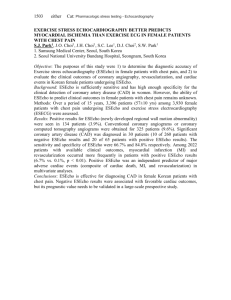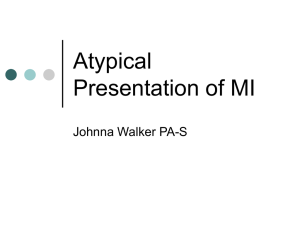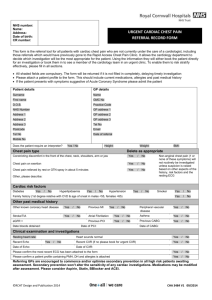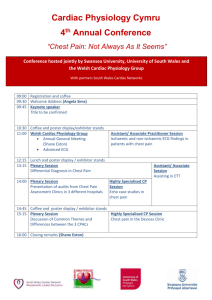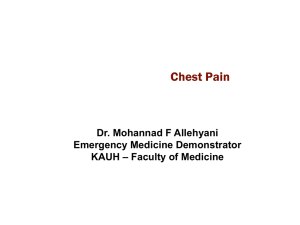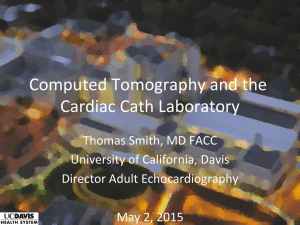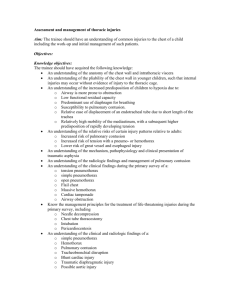Chest Pain and Cardiac Emergencies
advertisement
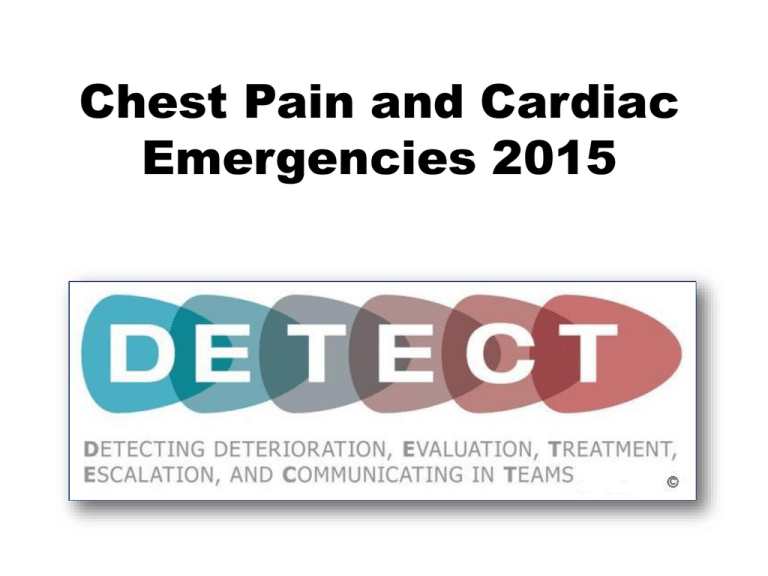
Chest Pain and Cardiac Emergencies 2015 Chest Pain and Cardiac Emergencies Welcome Chest Pain Certainty Simulation Introduction • Chest Pain is common – 6 potentially lethal causes to remember – Traditional approach (*full Hx) may be suboptimal • Assessment and Management should focus on – ABCDEFG and ECG – IV access, M.O.N.A. (may not be right anymore) – Senior review (#8500/mobile or Medical Registrar) Approach – Traditional vs. Emergency Life Threats Serious Causes Benign Causes (Common) Lethal Causes • • • • • • Myocardial Infarction (MI) Pulmonary Embolism (PE) Aortic Dissection (AD) Pneumothorax (Tension Pneumothorax) Pneumonia and Sepsis Oesophageal Perforation Myocardial Infarction and the Acute Coronary Syndromes ECG ECG 1 Acute Coronary Syndrome Assessment Assessment • Assessment – DETECT ABC approach • Pitfalls – Elderly Patients are often pain free – MI patients may have NO risk factors Acute Coronary Syndromes (ACS) Acute Coronary Syndromes STEMI NSTEMI UAP (30%) (25%) (35%) Atypical = Typical Acute Coronary Syndrome Management Management – MONA • • • • Morphine Oxygen Nitrate Aspirin – 0.1mg/kg IV and reassessment – titrated to 94% (no longer routine) – with care (avoid in RV infarction) – have a high threshold for not giving – low NNT and good safety profile • Other (ABCDEFG) – ACE Inhibitor, β Blockers, Clopidogrel & Prasugrel – Don’t ever forget glucose (BSL) – Fluids (often required in RV infarction) Management DOCUMENT YOUR PLAN CLEARLY • • • • • Referral – “ISBAR” COMMUNICATE Page 8500 and/or Cath Lab Team (STEMI) Your Registrar Consultant (in hours) Medical Registrar (out of hours) EFFICIENTLY Intro - I am Andrew the Intern covering A5C Situation and Background - I have Mrs Smith who is in hospital with abdominal pain that CLEARLY was thought to be fromAND Gallstones – she now has Chest pain & ST Elevation in AVF, II and III • Assessment – obs Response – review Management • Resuscitation, Specific (MONA) and Supportive • Disposition – Catheter Laboratory – Cardiac Unit (A5a, A5c) – CCU (A5b) – Cardiothoracics (C3c and D3c) – Respiratory Ward - PE and Pneumothorax (B5a) – ICU (E3a and E3b) – Home & follow up (e.g. EST, Cardiac CT, MIBI, Echo) Chest Pain Risk Stratification and State Policy ALL PROTOCOLS ARE ON ED INTRANET Other Causes of Chest Pain Pulmonary Embolism Aortic Dissection • Uncommon 5/100,000 • Overall Mortality is 27% in hospital, 1% per hour and >90% untreated • Ratio of MI to Dissection is 3000:5 (so it i s often missed and treated as MI) • Risk Factors – Hypertension, Cardiothoracic Surgery, Collagen Vascular Disease • Stanford – A & B (‘A’ proximal involvement) • CXR and BP both arms have limited value! Pneumothorax Arrhythmia Recognition and Management Has the patient arrested? Perfusion No Pulse ALS Algorithm Pulse Assessment of Stability Is the patient stable? Are there any adverse signs? Stability and Adverse Signs Extremes of Heart Rate *Blood Pressure and Perfusion Chest Pain Signs of Acute Heart Failure Arrhythmias • The Mantra / Approach – How is the patient? What is the Cause? – IV, O2, Monitor – Call for assistance • Assessment of Rhythm – Assessment of Pulse and Adverse Features – Narrow Complex vs. Broad Complex – Regular vs. Irregular – Slow, Fast vs. Very Fast Causes of Bradycardia/Tachycardia? Drugs Ischaemia Electrolytes Take Home • • • • • • 6 lethal causes ‘Atypical = Typical’ (Non-cardiac = Non-cardiac) A – G approach Serial ECGs Call for senior help Call for help (ALS team) for patients with adverse signs including refractory chest pain, shock, extremes of heart rate and cardiac failure

